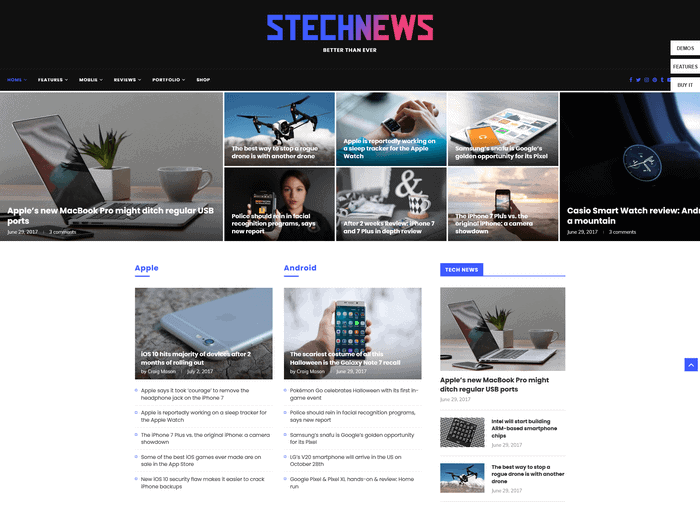Discover the Best tech blog for the most up to date Trends and Developments in Modern technology
Discover the Best tech blog for the most up to date Trends and Developments in Modern technology
Blog Article
Understanding the Rise of Edge Computer in Today's Digital Globe
In the swiftly evolving landscape of modern technology, edge computer becomes a pivotal force, reshaping exactly how information is refined and utilized. This paradigm shift is driven by the proliferation of IoT devices and a rising need for instant data handling. By transitioning data administration closer to the source, side computing addresses critical latency concerns while optimizing data transfer use and enhancing safety and security actions. As sectors pivot towards smarter, much more reliable systems, understanding the subtleties and effects of this technical development comes to be crucial. What does this mean for future advancements and the digital environment all at once?
What Is Edge Computing
Edge computer, although a relatively recent advancement in the world of technology, fundamentally transforms exactly how information is processed and taken care of by bringing computation and data storage closer to the place where it is needed. Unlike traditional cloud computing designs, which frequently depend on central data centers that can be geographically far-off, edge computer decentralizes information handling. This distance minimizes latency, enhances real-time information handling, and boosts the total user experience by making sure much faster action times.
At its core, edge computer involves a network of localized gadgets and framework, such as sensing units, routers, and portals, capable of processing data at or near the resource. This localized handling ability is especially essential for applications calling for immediate data analysis, such as autonomous automobiles, commercial automation, and wise cities. Additionally, by unloading information processing tasks from main servers, edge computing reduces transmission capacity needs and improves information privacy and security, as sensitive information can stay on-site instead of passing through substantial networks.

Secret Vehicle Drivers of Fostering
Numerous elements are pushing the fostering of edge computing in today's digital landscape. Among the key chauffeurs is the exponential boost in connected tools, often described as the Internet of Points (IoT) This surge develops vast amounts of information that require to be refined swiftly and effectively. Edge calculating addresses this need by making it possible for data processing closer to the data source, lowering latency and boosting real-time decision-making capacities.
Another significant motorist is the need for improved data transfer effectiveness. Central cloud systems can come to be overloaded with the large volume of data created by IoT gadgets, resulting in traffic jams (Best tech blog). By refining information at the side, companies can relieve network congestion and boost overall system performance
Moreover, security and privacy concerns are pressing organizations towards side computer. By refining delicate information in your area, companies can alleviate dangers linked with information transmission and exposure to possible cyber threats.
The rise of applications requiring real-time handling, such as autonomous automobiles and increased truth, additionally demands the fast feedback times that border calculating gives. Collectively, these motorists are making edge calculating an indispensable component of contemporary IT facilities, paving the means for its extensive adoption throughout different industries.
Advantages Over Cloud Computing
Exactly how does edge computing differentiate itself from standard cloud computing? Mostly, edge computer brings information handling closer to the source of information generation, usually on local tools or nearby web servers, instead than counting on central information.
Furthermore, edge computer boosts data transfer performance (Best tech blog). By refining data in your area, just the necessary information is transferred to the cloud for more evaluation or storage, lowering the quantity of information that passes through the network. This not just reduces network blockage however additionally lowers data transmission costs
Edge computer also offers better data personal privacy and safety. Sensitive information can be refined in your area without being sent out to the cloud, minimizing the exposure to potential cyber hazards. This is especially advantageous for fields dealing with secret information, such as healthcare and economic solutions.
Furthermore, edge computer makes certain higher durability and reliability. Local processing enables continued procedure even when connectivity to the cloud is compromised, keeping necessary features and services in spite of possible network disturbances. These advantages jointly demonstrate edge computer's transformative potential in view website optimizing performance and safety in digital ecological communities.
Factors To Consider and challenges
While side computing uses numerous advantages, it additionally presents one-of-a-kind obstacles and considerations that need to be resolved to fully understand its capacity. One substantial challenge is data safety and personal privacy. Processing data closer to the source increases the risk of unapproved access, requiring durable file encryption and rigorous protection protocols to shield delicate information. Furthermore, managing and checking a decentralized network of edge devices can be complicated, requiring advanced tools and techniques to make sure seamless procedure and maintenance.
Another consideration is the scalability of edge computer solutions. As the number of connected gadgets grows, so does the demand for refining power at the edge, which can cause source constraints. Organizations needs to very carefully plan their facilities to suit this growth without compromising performance or effectiveness.
Interoperability is another important element. With different equipment and software parts entailed, making sure compatibility and smooth integration can be difficult. Standardization initiatives are important to help with interaction in between diverse systems.
Future Fads in Side Computing
Preparing for the future, edge computer is poised to transform various markets by allowing faster data processing and minimizing latency. As the volume of information created by IoT tools continues to grow, edge computer will come to be significantly crucial in handling this increase effectively. linked here One significant fad is the integration of synthetic knowledge at the side, enabling real-time analytics and decision-making without counting on cloud-based resources. This shift is expected to enhance applications in independent vehicles, smart cities, and medical care, where immediate information handling is important.
An additional emerging pattern is the development of edge-native applications made specifically to utilize the unique abilities of side computer. These applications will enhance performance and resource utilization, resulting in increased efficiency throughout numerous sectors. Moreover, improvements in 5G modern technology will additionally boost side computer by giving the required facilities for high-speed, low-latency interaction between tools and side nodes.
Conclusion
Side computer's surge is driven by the spreading of IoT gadgets and the demand for real-time data handling, which boosts performance by decreasing latency and decentralizing information administration. This approach minimizes data transfer inefficiencies and protection issues, helping with improvements in applications like independent automobiles and wise cities. Despite difficulties such as infrastructure intricacy and integration, the future of side computing guarantees a more responsive digital ecosystem, with continued developments shaping its advancement and expanding its applicability throughout industries.
Side computer, although a fairly recent innovation in the realm of technology, essentially transforms just how information is processed and taken care of by bringing computation and information storage closer to the area where it is required. Unlike conventional cloud computing designs, which usually count on central information centers that can be click geographically far-off, side computer decentralizes information handling. In addition, by offloading data handling tasks from central web servers, edge computer minimizes data transfer demands and boosts information personal privacy and security, as sensitive details can continue to be on-site instead than passing through extensive networks.

Report this page